Balbharti Maharashtra State Board Class 9 History Solutions Chapter 4 Economic Development Notes, Textbook Exercise Important Questions and Answers.
Maharashtra State Board Class 9 History Solutions Chapter 4 Economic Development
Class 9 History Chapter 4 Economic Development Textbook Questions and Answers
1.A Choose right option and write the sentence:
Question 1.
On 19th July, 1969 ______ major banks in India were nationalised.
(a) 12
(b) 14
(c) 16
(d) 18
Answer:
(b) 14
Question 2.
_________ declared a 20 – point programme.
(a) Pandit Nehru
(b) Lai Bahadur Shastri
(c) Indira Gandhi
(d) P.V. Narasimha Rao
Answer:
(c) Indira Gandhi
![]()
B. Identify the wrong pair and rewrite the corrected one:
Question 1.
(1) Kawasajee Dawar – Iron and Steel factory.
(2) Dr. Datta Samant – Leadership of mill workers.
(3) N. M. Lokhande – Holiday for mill workers.
(4) Narayan Surve – Depiction of lives of workers through poems.
Answer:
Wrong Pair : Kawasajee Dawar – Iron and Steel factory.
2.A Complete the following chart:
Question 1.
| Five Year Plan | Duration | Purposes |
| First | ………………. | Agriculture and Social Development |
| Second | 1956 -1961 | Industrialisation |
| Third | ……………… | Elimination of inequality, increasing opportunities for employment, increase in national income. |
| …………. | 1969 -1974 | Scientific research, health and family planning. |
| Fifth | ……………. | ………………….. |
Answer:
| Five Year Plan | Duration | Purposes |
| First | 1951 -1956 | Agriculture and Social Development |
| Second | 1956 -1961 | Industrialisation |
| Third | 1961 -1966 | Elimination of inequality, increasing opportunities for employment, increase in national income. |
| Fourth | 1969 -1974 | Scientific research, health and family planning. |
| Fifth | 1974 -1979 | Making India economically self-sufficient by alleviating poverty. |
B. Explain the concepts:
Question 1.
Mixed Economy
Answer:
(i) In a capitalist system, the means of production are privately owned. In a socialist economy, the means of production are owned by the State in the name of the society.
(ii) A mixed economy works both in the private and the public sector.
(iii) In order to achieve economic development of modem India, we gave preference to a model of ‘mixed economy’. We can see three parts in this kind of economy:
(a) Public Sector: The industries in this sector are completely under the control and management of the government. For example, production of defence equipment.
(b) Private Sector: The industries in this sector are owned by private industrialists. Of course, the government supervises and controls them too. For example, consumer goods.
(c) Joint Sector: In this sector, some industries are owned by private industrialists, while some are run under government management.
(iv) For mixed economy to run smoothly there is a need for co-ordination between the private sector and the public sector.
(v) This system aims at maximisation of production and popular participation on a large scale.
(vi) An effort has been made in this system to bring together the good aspects of both the capitalist and the socialist systems.
(vii) A mixed economy cannot ignore the profit motive, entrepreneurship, discipline, time bound planning, etc.
Question 2.
20 – Point Programme
Answer:
20-Point Programme: Prime Minister Indira Gandhi announced the 20-Point Programme on 1st July 1975 and resolved to make efforts towards rapidly becoming a developed nation. The main provisions of the 20 point programme are as follows:
- Land ceiling for cities and agricultural land, equal division of wealth, minimum wages for workers, increase in water conservation schemes.
- Workers’ participation in industry, national training scheme, freeing bonded labour.
- Prevention of tax evasion, economic crimes and smuggling.
- Regulation of prices of basic necessities, improvement in the public distribution system.
- Improvement in the textile industry by developing handloom sector, waiving loans for weaker sections, housing, communication facilities, making educational equipment available to schools.
![]()
3.A Give reasons.
Question 1.
Independent India opted for mixed economy.
Answer:
(i) Our Prime Minister Pandit Nehru adopted the middle path rather than taking recourse to any extremes. Some countries had adopted Capitalism, while some had adopted Socialism. Each type of economy had its own advantages.
(ii) In a capitalist system, the means of production are privately owned. In a socialist economy, the means of production are owned by the State in the name of the society.
(iii) A mixed economy works both in the private and the public sector. In order to achieve economic development of modem India, we gave preference to a model of ‘mixed economy’.
Question 2.
Banks were nationalised in 1969.
Answer:
(i) During the tenure of Prime Ministers Pandit Nehru and Lai Bahadur Shastri, banking was a monopoly of the private sector.
(ii) These banks represented different industrial groups. The Directors of these banks were working towards developing industrial sector and increasing its profit.
(iii) In order to stop this, the government nationalised the ‘Imperial Bank’ in 1955 and it got converted into State Bank of India.
(iv) This Bank opened several branches all over the country in a short while and played a major role in development.
(v) India had adopted a mixed economy after independence. Nationalisation of banks was essential to cover the deficits if they occurred while implementing different schemes.
(vi) Also the profit of these banks would come into the government treasury once they were nationalised. Prime Minister Indira Gandhi nationalised 14 banks on 19th July, 1969.
Question 3.
Mill workers went on strike.
Answer:
(i) During the Diwali of 1981, the workers expected to get a bonus of 20%.
(ii) The Rashtriya Mill Mazdoor Sangh, which was negotiating with the employers, agreed upon 8 to 17% bonus without taking the workers into confidence.
(iii) The cut in the bonus proved to be the cause of unrest. Some workers went to Dr. Datta Samant.
(iv) They asked him to accept their leadership. Workers of 65 mills came together and Dr. Datta Samant led the strike. On 18th January 1982, two and a half lakh workers went on strike.
B. Answer the following questions in 25 to 30 words.
Question 1.
Which programmes were started in the Eighth Five Year Plan?
Answer:
Following programmes were started in the Eighth Five Year Plan:
- Pradhanmantri Rozgar Yojana
- Mahila Samriddhi Yojana
- Rashtriya Samajik, Arthik Sahayya Yojana
- Midday Meal Scheme
- Indira Mahila Scheme
- Ganga Kalyan Scheme
Question 2.
Which heavy industries were set up under the Second Five Year Plan?
OR
Which projects were started in the Second Five Year Plan?
Answer:
(i) Iron and steel industries at Durgapur, Bhilai and Rourkela; Chemical fertilisers plant at Sindri; rail engine factory at Chittaranjan; factory of railway bogies at Perambur, Ship building factory at Vishakhapattanam and other heavy industries were set up in the Public Sector.
(ii) Huge dams like Bhakra-Nangal, Damodar, etc. were built to make water available for agriculture.
Class 9 History Chapter 4 Economic Development Additional Important Questions and Answers
Choose the correct option from the given options and and rewrite the statements:
Question 1.
India removed the import restriction on several commodities for _____ countries.
(a) BRICS
(b) SAARC
(c) Third – World
(d) Middle – East countries
Answer:
SAARC
![]()
Question 2.
The efforts of _____ resulted in the weekly Sunday holiday for mill workers from 1st January 1882.
(a) Mahatma Jyotirao Phule
(b) Sane Guruji
(c) Babu Jagjeevan Ram
(d) Narayan Meghaji Lokhande
Answer:
Narayan Meghaji Lokhande
Question 3.
During the tenure of Prime Minister Indira Gandhi ,________ a group in the Congress Party, made a demand for nationalisation of commercial banks.
(a) Congress Socialist Party
(b) Congress Forum for Socialist Action
(c) Congress wing of Socialist Propaganda
(d) Agency of Socialist Congress
Answer:
Congress Forum for Socialist Action
Question 4.
In 1995, India became a member of _______.
(a) World Trade Organisation
(b) International Monetary Fund
(c) GATT
(d) SAARC
Answer:
World Trade Organisation
Question 5.
In order to overcome drought and food shortages ______ undertook the experiment of Green Revolution.
(a) Chaudhary Charansingh
(b) Gulzarilal Nanda
(c) H D Deve Gowda
(d) Lal Bahadur Shastri
Answer:
Lal Bahadur Shastri
Question 6.
During the tenure of Prime Minister P.V. Narasimha Rao, _______ was our Finance Minister.
(a) John Mathai
(b) Yashwant Sinha
(c) P. Chidambaram
(d) Dr. Manmohan Singh
Answer:
Dr. Manmohan Singh
Question 7.
The first textile mill was started in Mumbai on 11th July, 1851 by _______.
(a) Pirojsha Burjorji Godrej
(b) Jamsedji Nusserwanji Tata
(c) Kawasjee Dawar
(d) Azim Hashim Premji
Answer:
Kawasjee Dawar
Question 8.
The new government of Janata Party ended the fifth Five Year plan by March 1978 and started the _______ from April 1978.
(a) Development Plan
(b) Enrolling Plan
(c) Rolling Plan
(d) Redemption Plan
Answer:
Rolling Plan
Question 9.
Manmohan Singh signed the agreement with the WTO and launched the policy of privatisation, ______ and globalisation.
(a) Liberalisation
(b) Industrialisation
(c) Maximisation
(d) Profitisation
Answer:
Liberalisation
Question 10.
On 18th January 1982, two and a half lakh workers went on a strike under the leadership of _________.
(a) Dhondo Keshav Karve
(b) Baba Amte
(c) Dr. Datta Samant
(d) Anna Hazare
Answer:
Dr. Datta Samant
Question 11.
The _______ plan is a reflection of the liberalisation and free market policy adopted in 1991.
(a) Seventh
(b) Eighth
(c) Fifth
(d) Sixth
Answer:
Eighth
Question 12.
The government nationalised the ‘Imperial Bank’ in 1955 and it got converted into ______
(a) Syndicate Bank
(b) Bank of India
(c) State Bank of India
(d) Reserve Bank of India
Answer:
State Bank of India
Question 13.
The term ‘Girangaon’ means ________.
(a) Town of hills
(b) Town of mills
(c) Group of industries
(d) Cottage industries
Answer:
Town of mills
![]()
Identify and write the wrong pair in the following sets:
Question 1.
(1) Public Sector – Controlled and managed by government
(2) Mixed Economy – Coordination in private and public sector
(3) 20 point programme – Nationalisation of 13 textile mills.
(4) Increased oil prices – Invasion of Kuwait by Iraq.
Answer:
Wrong Pair : 20 point programme Nationalisation of 13 textile mills.
Question 2.
(1) Congress Forum for Socialist Action – demanded nationalisation of banks.
(2) Rashtriya Mill Mazdoor Sangh – negotiations with the employer.
(3) Imperial Bank – converted in State Bank of India.
(4) National Stock Exchange – existed before WTO.
Answer:
Wrong Pair : National Stock Exchange – existed before WTO.
Question 3.
(1) SAPTA – Preferential trade
(2) SAARC – removal of import restrictions by India
(3) SEBI – established in 1998
(4) WTO – regulate global trade
Answer:
Wrong Pair : SEBI – established in 1998
Question 4.
(1) Barrister A.R.Antulay – leader of Rashtriya Mill Mazdoor Sangh
(2) Dr. Manmohan Singh – Finance Minister
(3) Indira Gandhi – nationalised 14 banks
(4) V.P. Singh – waived off loans of the farmers
Answer:
Wrong Pair : Barrister A.R.Antulay – leader of Rashtriya Mill Mazdoor Sangh
Question 5.
(1) Babasaheb Bhonsale – Chief Minster of Maharashtra
(2) Namdev Dhasal – Marathi Poet
(3) Shahir Sable – Programmes of public education
(4) Chandrashekhar – Associate of Mahatma Jyotirao Phule.
Answer:
Wrong Pair : Chandrashekhar – Associate of Mahatma Jyotirao Phule.
Complete the concept maps and flow charts of various programmes and schemes introduced:
Question 1.
Answer:
| SECOND FIVE YEAR PLAN (1956-1961) | |
| Iron and Steel industries | Durgapur, Bhilai, Rourkela |
| Chemical Fertilisers Plant | Sindri |
| Rail Engine Factory | Chittaranjan |
| Factory of railway bogies | Perambur |
| Ship building Factory | Vishakhapattanam |
Question 2.
Answer:
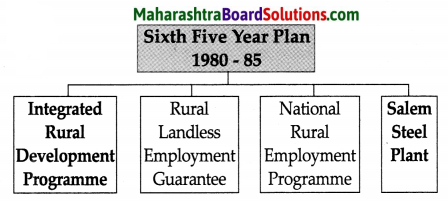
Question 3.
Answer:

Question 4.
Answer:
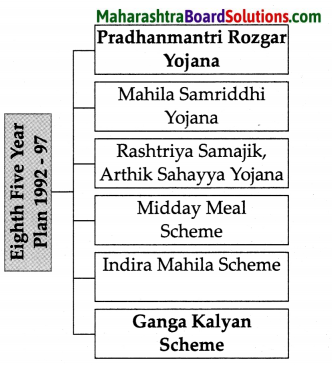
Question 5.
Answer:
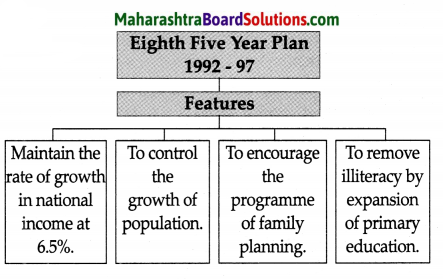
Question 6.
Answer:
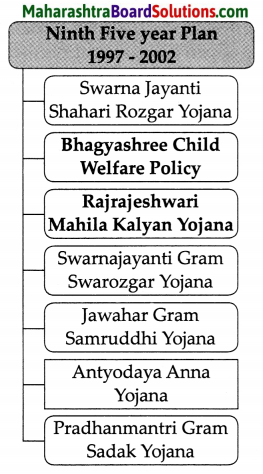
![]()
Question 7.
Answer:
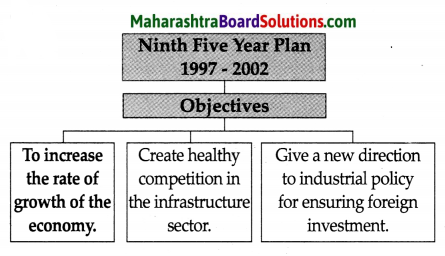
Give Reasons:
Question 1.
India established the Planning Commission to deal with economic repercussions of British colonialism,
Answer:
(i) The colonial power had exploited India economically. The country faced severe problems like poverty, unemployment, population growth, low standards of living, low productivity of agriculture and industries and backwardness in the fields of knowledge, science and technology. Planning was essential to solve these problems.
(ii) India established the Planning Commission in 1950 with Prime Minister Pandit Jawaharlal Nehru as its Chairman.
(iii) It formulated India’s five year plans that included rural and agricultural development, : balanced industrialisation, provision for a minimum standard of living and economic development consistent with democratic ideals.
(iv) It focused on people’s participation and individual development in the formulation and implementation of the five year plans.
Read the passage and answer the questions.
Passage I
Issues of workers: The first textile mill was started in Mumbai on 11th July, 1851 by Kawasjee Dawar. Eventually, mills started in Dadar, Parel, Bhaykhala, Shivdi, Prabhadevi and Worli. This part came to be i known as Girangaon or ‘town of mills’. In the 1980s, the increasing unrest among workers was due to the economic conditions in other sectors. In some industries the wages of the workers were increasing. They were also getting more amounts as bonus. They were getting more facilities than the textile mill workers.
In the Diwali of 1981, the workers expected to get a bonus of 20%. The Rashtriya Mill Mazdoor Sangh, which was negotiating with the employers, agreed upon 8 to 17% bonus without taking the workers into confidence. The cut in the bonus proved to be the cause of unrest. Some workers went to Dr. Datta Samant. They asked him to accept their leadership, Workers of 65 mills came together and Dr. Datta Samant led the strike. On 18th January 1982, two and a half lakh workers went on strike. Girangaon mills stopped running making it seem like Mumbai’s heart topped throbbing.
The Chief Minister of Maharashtra, Barrister A. R. , Antulay set up a committee to solve this issue. Later Babasaheb Bhosale became the Chief Minister of Maharashtra State. He insisted that as per law, he would talk only with the Rashtriya Mill Mazdoor Sangha. Dr. Datta Samant demanded that the law be revoked. In the beginning, the striking workers received help from their native villages. It was also , not very difficult for them to help each other. They set up departmental committees and distributed food grains, assistance in the form of funds, etc. The left parties had supported the strike. As the strike , dragged on, efforts were made to split the striking workers’ ranks. Even as the strike completed 6 months, the central government completely ignored it. The workers started a Jail Bharo Agitation’. In , September 1982, one and a half lakh workers took a march on the Legislative Assembly of Maharashtra State. It didn’t help at all. The strike completed a year. This was the first strike to have gone on for a year. In this period, about one and a half lakh workers became unemployed. As polyester had come into greater demand than cotton cloth, the sale of mill , cloth had already got affected. The mills moved from Mumbai to Surat in Gujarat. The Central government nationalised 13 textile mills. Appointment of i arbitrators did not help to resolve the issue.
Question 1.
Name the worker’s union mentioned in the passage. Why were the workers agitated with it?
Answer:
(i) The worker’s organisation mentioned in the passage is Rashtriya Mill Mazdoor Sangh.
(ii) The workers were agitated because they received less bonus and facilities in their textile mills, whereas economic conditions in the other sectors of the economy were far better.
(iii) The Rashtriya Mill Mazdoor Sangh that negotiated with the employers, settled at 8 to 17% of bonus as against the expectation of 20% by the workers.
(iv) The cut in the bonus led to the workers agitation.
![]()
Question 2.
State the contribution of Dr. Datta Samant in raising workers issues in Maharashtra?
Answer:
(i) Dr. Datta Samant was the leader of two and a half lakh workers who went on strike.
(ii) He demanded that the law be revoked which had empowered Rashtriya Mill Mazdoor Sangh alone to talk on behalf of the workers.
Question 3.
What is mixed economy?
Answer:
(i) In a capitalist system, the means of production are privately owned. In a socialist economy, the means of production are owned by the State in the name of the society.
(ii) A mixed economy works both in the private and the public sector.
(iii) In order to achieve economic development of modem India, we gave preference to a model of ‘mixed economy’.
Passage II
General Agreement on Tariffs and Trade (GATT) existed at the international level before the World Trade Organisation came into being. It regulated commerce. In India there were opposed, extreme views about the World Trade Organisation. Yet India decided to take its membership. The provisions of the World Trade Organisation are regarding grants, import-export, foreign investment, agriculture, technology and services. The sectors of electricity, water transportation, education and health rapidly commercialised since India became a member of the World Trade Organisation. As per the various reports of the World Trade Organisation, India has made a considerable improvement in different areas like reduction in the below poverty line (BPL) population, decline in infant mortality, availability of facilities regarding drinking water and waste water management. India signed the South Asian Preferential Trade Agreement (SAPTA) along the lines of the World Trade Organisation. India removed the import restrictions on several commodities for SAARC countries. India also gave discounts on import duties. India opened up the insurance sector to private and foreign investment.
Question 1.
Study the passage and give the full forms of GATT and SAPTA.
Answer:
GATT – General Agreement on Tariff and Trade.
SAPTA – South Asian Preferential Trade Agreement.
Question 2.
Explain, in your own words, the economic policy of “Make in India”.
Answer:
’Make in India’ is an economic policy as well as an organised progamme of the Government of India to encourage and promote various companies and enterprises to start manufacturing and producing goods in India. The aim of this initiative is to generate employment, enhance the skill of Indians and also to attract foreign investment.
Question 3.
What do the provisions of the WTO cater to?
Answer:
The provisions of the WTO cater to grants, import -export, foreign investment, agriculture, technology and services.
Answer the following questions in detail:
Question 1.
What is the fundamental principle of the Five Year Plans? Which economic goals are set forth by the Government?
Answer:
Fundamental principle of planning: A general principle of planning is the proportionate distribution of the resources of a country and the appropriate use of the human resources to fulfill the needs of the people.
Goals of Plans:
The general goals of the economic planning of India are as follows:
- Increase in the national income.
- Bringing about rapid industrialisation by focusing on the basic industries.
- Bringing about an increase in agricultural production so that the country becomes self-sufficient in foodgrain production.
- Use the human resources in the country optimally by availing increasing employment opportunities.
- Remove inequality in earnings and wealth.
- Maintain stable prices of commodities.
- Controlling the growth of population through family planning.
- Improve the standard of living by eradicating poverty.
- Develop social services.
- Make the economy self-sufficient.
![]()
Question 2.
Describe the prolonged agitation of the mill workers under Dr. Datta Samant.
Answer:
(i) In the beginning, the striking workers received help from their native villages. It was also not very difficult for them to help each other.
(ii) They set up departmental committees and distributed food grains, assistance in the form of funds, etc
(iii) The left parties had supported the strike. As the strike dragged on, efforts were made to split the striking workers’ ranks.
(iv) Even as the strike completed 6 months, the central government completely ignored it. The workers started a ‘Jail Bharo Agitation’.
(v) In September 1982, one and a half lakh workers took a march on the Legislative Assembly of Maharashtra State.
(vi) It didn’t help at all. The strike completed a year. This was the first strike to have gone on for a year.
(vii) In this period, about one and a half lakh workers became unemployed.
(viii) As polyester had come into greater demand than cotton cloth, the sale of mill cloth got affected. The mills moved from Mumbai to Surat in Gujarat.
(ix) The Central government nationalised 13 textile mills. Appointment of arbitrators did not help to resolve the issue.
Question 3.
Which enterprises came under government due to the lack of capital investment?
Answer:
(i) The industries like defence, scientific research, education, roads, railways, waterways, sea port and airport development require huge capital investment but the returns in these areas are delayed.
(ii) Not many private industrialists are keen to invest in these areas. In such a situation, the government has to take the initiative.
Question 4.
State the Industrial policy of 1973.
Answer:
(i) The industrial policy of 1973 increased the speed of development.
(ii) Priority was given in this policy to control the influence of heavy industries, industrial families and foreign industries and remove the imbalance in regional development.
(iii) The government focused on the development of small scale industries and cottage industries.
Question 5.
What were the aims of the ‘Third Five Year Plan’?
Answer:
(i) This plan was aimed at bringing about a balance in industries and agriculture.
(ii) The other goals of the plan included increase in national income, heavy industries, development in transport and mineral industry, alleviation of poverty and to expand the opportunities for employment.
Question 6.
What was the background for . the nationalisation of banks?
Answer:
(i) India had adopted a mixed economy after independence.
(ii) Nationalisation of banks was essential to cover the deficits if they occurred while implementing different schemes.
(iii) Also the profits of these banks would come into the government treasury once they are nationalised.
Question 7.
State the cultural contributions of the working class.
Answer:
(i) The working class has contributed culturally as well through folk theatre, folk art and literature. Anna Bhau Sathe, Shahir Amar Sheikh, Shahir Sable were popular for their programmes aimed at public education.
(ii) Poets like Narayan Surve, Namdev Dhasal, etc., portrayed the real life of the workers through their poems.
![]()
Question 8.
Who took responsibility to bring the Indian economy in sync with the global mainstream?
Answer:
(i) The year 1991 is very important in the history of modem India. After the 10th General elections, P. V. Narasimha Rao became the Prime Minister of India.
(ii) With Dr. Manmohan Singh as Finance Minister, he adopted the new economic policy of linking India’s economy with the global economy.
(iii) For this, fundamental changes were brought about in the Indian economy. Indian economy was brought in tune with the global mainstream.
Question 9.
Which corrective measures were taken by Manmohan Singh to relieve the crisis of the Indian economy?
Answer:
(i) Dr. Singh undertook many corrective measures. The situation began to change.
(ii) He removed the restrictions on foreign investments.
(iii) He restricted the licence system to 18 industries. In view of the increasing losses in the public sector industries, he opened up the public sector for investment by private industries.
(iv) In order to bring the share market under control, he established the Securities and Exchange Board of India (SEBI) in 1992.
(v) National Stock Exchange was computerised. He gave priority to remove the spectre of recession.
Question 10.
State the impact of corrective measures taken by Dr. Manmohan Singh on the economy of our country.
Answer:
(i) Foreign Investment in India grew during the first tenure of Dr. Manmohan Singh as Finance Minister.
(ii) India could recover the gold mortgaged with the Bank of England.
(iii) The government got the support of the capitalist class as well as the middle class.
(iv) As the government opened up the telecom sector, mobile phone services started all over the country.
(v) Dr. Manmohan Singh signed the agreement with the World Trade Organisation and launched the policy of “privatisation, liberalisation and globalisation.”
Question 11.
What were the objectives of the WTO?
Answer:
(i) In 1995, India became a member of the World Trade Organisation (WTO).
(ii) The organisation had the following objectives: to free trade between countries, to put an end to all those discriminatory laws, restrictions, rules and policies that are hurdles in the way of international free trade and to regulate global trade with the help of a formal multi – party mechanism.
Question 12.
Do you agree that membership with the WTO has ushered in changes in the economic sector of our country? State the reason for your answer.
Answer:
(i) Yes, of course. The provisions of the World Trade Organisation have included grants, import-export, foreign investment, agriculture, technology and services.
(ii) The sectors of electricity, water transportation, education and health have been rapidly commercialised since India became a member of the World Trade Organisation.
Question 13.
State the improvements which have occurred in our economy as per the reports of WTO.
Answer:
As per the various reports of the World Trade Organisation, India has made considerable improvement in different areas like reduction in the below poverty line (BPL) population, decline in infant mortality, availability of facilities regarding drinking water and waste water management.
![]()
Question 14.
Which economic challenges were faced by the Government of Prime Minister Chandra Shekhar?
Answer:
(i) During the tenure of Chandra Shekhar the rate of inflation was 17%.
(ii) Economic growth rate had decreased by 1.1%. India had foreign exchange reserves only enough to last for imports for a week.
(iii) It had become difficult to pay back its loan and the interest on it.
(iv) In May 1991, the government had tried to control the situation by selling some of its gold reserves and by mortgaging some.
Question 15.
Which economic liabilities were incurred by V. P. Singh government?
Answer:
(i) The V. P. Singh government had incurred a liability of over 10 thousand crore rupees on the economy by waiving off the loans of all the farmers.
(ii) The proportion of internal loans of central and state government together to the Gross Domestic Product was 55%.
(iii) In 1980-81 foreign loan was 2350 crore dollars. It increased to 8380 crore dollars in 1990-91.
(iv) At this time, India had foreign exchange reserves of only 100 crore dollars.
(v) This also had the background of the increased oil prices due to the invasion of Kuwait by Iraq.
(vi) It became difficult for India to raise a loan. Even the non-resident Indians started withdrawing their deposits in foreign currency from India.
Identify the picture and give relevant information.
Question 1.

Answer:
(i) Nationalisation of banks was essential to cover the deficits if they occurred while implementing different schemes and profit of these banks came under the government treasury.
(ii) Also the profit of these banks would come into the government treasury once they were nationalised. Prime Minister Indira Gandhi nationalised 14 banks on 19th July, 1969.
Question 2.
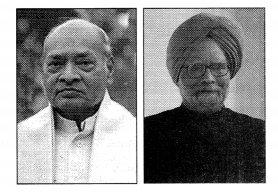
Answer:
(i) P. V. Narasimha Rao and Manmohan Singh.
(ii) They removed the restrictions on foreign investments.
(iii) Restricted the license system to 18 industries.
(iv) Opened up the public sector for investment by private industries.
(v) Established the SEBI (Securities and Exchange Board of India) in 1992 to regulate and bring share market under control.
(vi) Foreign investment in India grew.
(vii) India could recover the gold mortgaged with the Bank of England.